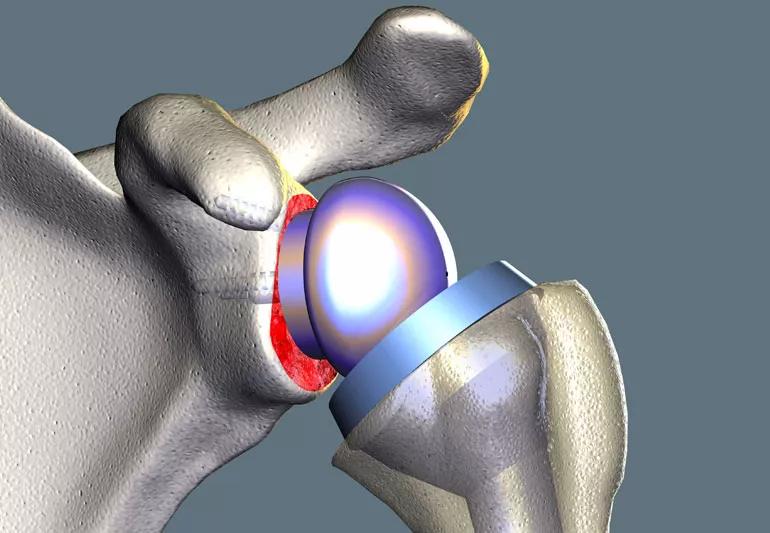An orthopaedic surgeon outlines the alternatives

You’ve lived with debilitating shoulder pain for a while. You’ve likely tried physical therapy, injections and other treatments, but the pain persists. So you need surgery — but how does your surgeon decide what options you have and whether shoulder replacement will work for you?
Advertisement
Cleveland Clinic is a non-profit academic medical center. Advertising on our site helps support our mission. We do not endorse non-Cleveland Clinic products or services. Policy
Orthopaedic surgeon Vahid Entezari, MD, discusses the differences among two types of shoulder replacements and whether you might be a candidate for shoulder fusion surgery.
The shoulder is a ball and socket joint with more range of motion than any other joint in the body. Both ball and socket are covered by a shiny layer of cartilage that allows you to easily move your shoulder. Rotator cuff muscles are a set of four muscles that surround the shoulder joint, and their main role is to keep the ball stable on the socket and help with movement.
Repetitive injury or normal wear and tear of the joint can lead to loss of cartilage, which is called arthritis. Rotator cuff tendons also can tear over time. Mild cases of arthritis can be treated with activity modification, physical therapy and cortisone injections. Similarly, chronic rotator cuff tears or smaller tears can usually be treated with physical therapy or cortisone injections and eventually may need to be repaired. When these measures fail, your surgeon might recommend joint replacement.
Also called arthroplasty, joint replacement is one of the most successful surgeries of the 21st century. Similar to joint replacement of the hip and knee, shoulder replacement involves taking out the arthritic portions of the joint and replacing it with metal and durable plastic to relieve pain and improve function.
Advertisement
In an anatomic shoulder replacement, the surgeon will replace the end of the arm bone (the ball) with a metallic ball and the shoulder blade with a durable plastic socket, and the joint will continue to rely on the rotator cuff tendons for stability and movement. This surgery is usually performed in patients in their 50s, 60s and 70s who have severe arthritis of the joint, and it has been very successful in relieving pain and restoring near normal range of motion.
The other type of shoulder replacement is called reverse shoulder replacement. As the name implies, the ball and socket parts of the joint are reversed. This means the ball is placed on the shoulder blade and the plastic socket is placed at the end of the arm bone. Because the socket is deeper, in reverse shoulder replacement the ball can sit inside the socket and no longer needs rotator cuff tendons to keep it stable. Because of this, reverse shoulder replacement can be done for patients who have a torn rotator cuff and for patients who have failed other types of shoulder replacements or have severely splintered fractures.
Reverse shoulder replacement is commonly performed in patients in their 60s, 70s and 80s, and because of its versatility, has become the most common type of shoulder replacement in the U.S. since 2013.
Our technique and implant design have improved significantly in recent decades and this has made shoulder replacement the fastest growing joint replacement in the U.S.
So, how is recovery after shoulder replacement? Dr. Entezari says you usually will be offered a nerve block prior to surgery that will also numb the arm for a few days after surgery to minimize your pain. You also will need general anesthesia for the surgery, which typically lasts less than two hours. You commonly stay one night in the hospital so your pain can be controlled, and you will want to protect the arm from active use for six weeks for soft tissue to heal and to avoid dislocation — gradually increasing activity with instruction from your surgeon. Some patients will need to do physical therapy. He says most patients start do strengthening exercises at three months and continue to improve for up to a year following the surgery.
“While shoulder replacement remains the main treatment option for patients with advanced joint disease, fusion surgery is a viable alternative for relatively younger patients who have high physical demands, such as jobs in construction,” Dr. Entezari says. “Fusion surgery has been around longer than shoulder replacement, but nowadays it’s not as common as shoulder replacement.”
In fusion surgery, the surgeon removes the ball and socket and fuses the upper arm bone to the shoulder blade. This eliminates the ball and socket motion so the pain is gone, but it does limit the range of motion. The arm will continue to have motion up to the shoulder level through the motion of the shoulder blade. This allows patients to maintain their function at the waist level without the worry of shoulder replacement wear and tear.
Advertisement
After fusion surgery, Dr. Entezari says you’ll need to immobilize your shoulder for 10 to 12 weeks and gradually work on your range of motion to resolve the stiffness.
In deciding which procedure is best for you, your surgeon likely will consider:
“You can expect a shoulder replacement to last 15 to 20 years, so if you’re in your 60s or 70s, you’ll most likely only need one surgery,” Dr. Entezari explains. “But if you’re in your 40s, you will need another replacement — especially if you are active — so fusion surgery might be the best option for you.”
You aren’t a good candidate for shoulder replacement surgery if you have muscle weakness, severe nerve injuries in the arm, or recurrent instability associated with epilepsy, he notes.
“Shoulder replacement surgery is a reliable procedure for pain relief and improving function,” Dr. Entezari says. “However, fusion remains an important alternative if shoulder replacement isn’t an option for you.”
A healthy shoulder typically allows you to raise your arm up and over your head at 160 degrees — like you’re reaching for something directly over your head, Dr. Entezari says. With fusion surgery you can expect only about half of that. With replacement surgery, you can expect to achieve 140 degrees of movement, depending on your overall physical condition before the surgery.
Advertisement
Talk with your surgeon to explore your options, Dr. Entezari stresses. That way you can get the greatest pain relief and be happy in the long-term.
Advertisement
Learn more about our editorial process.
Advertisement

Don’t ignore obvious warning signs of more serious shoulder issues

A chiropractor offers guidance and simple exercises

How to tell the difference

The short answer from an orthopedic surgeon

Most recommended precautions center around minimizing bruising or swelling

Even one drink can have an impact on your cognitive function leading to slurred speech, blurred vision and impaired memory

Type 2 diabetes isn’t inevitable with these dietary changes

Applying a hot or cold compress can help with pain